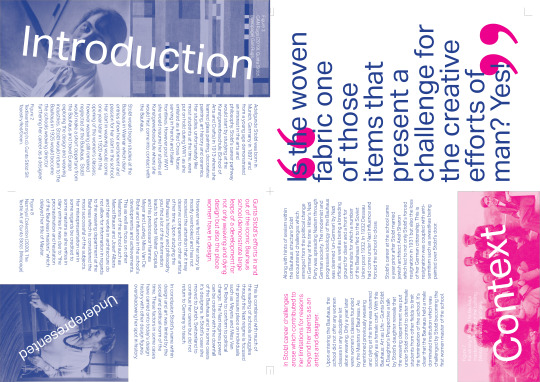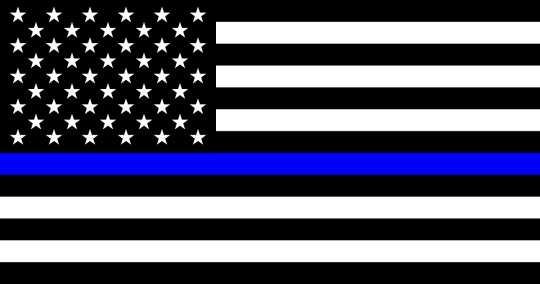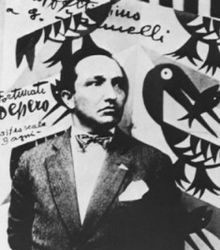Text


Overall Reflection
Throughout this course my experience has allowed for a better insight into not only my own design history but also broader design history. Of course, the starting point of outlining my own journey as a designer created a foundation for my understanding in how we look to make contributions to design history. Following this the creation of a zine which was complemented with research of Gunta Stolzl and her underappreciated history saw how design history can be hidden but can be brought to light to influence design history.
Prior to engaging in this course my understanding of design history was not non-existent but very minimal. Of course from a external perspective design history is a listen of events and individuals whom have placed themselves in creative history, now after in depth insight my understanding that individuals design contributions looks beyond the topic and can change our society.
Multiple practical activities provided further experiences which aided further understanding of different mediums and design movements. Activities such as drawing self portraits and colleagues where experiences which pushed me beyond just digital formats.
Some of the individual things I have learnt from this course include. Being able to take feedback, engage in mediums that are not digital and accept the responsibility of taking design and it's history forward.
0 notes
Text

Week 11
Week 11 saw how design has profound impact on the modern world’s problems. Designs integration with the perspective of modernism, colonialism and ingenious culture has seen intentions with positive and negative outcomes.
Dr Tristan Schultz raised an interesting point in regards to the role of designers. “As designers we are not trying to see the world as it is, more as it will be”. This quote speaks to the efforts made by designers to further the importance of particular causes in this case civil rights.
From an indigenous perspective the term tera nullas has a history of isolation, premove and disenfranchised factors which look over a dark history. Acknowledge of this history through design most notably illustrations which have become loud vocal points in expressing social activism. As seen with charlotte Allingham her work depicts the social trend in addressing Aboriginal injustice.
Allingham, C. (n.d.). Always was, always will be Aboriginal land. [Webpage] OnlyMelbourne. Available at: https://www.onlymelbourne.com.au/always-was-always-will-be-aboriginal-land.

Writer Claire Coleman wrote an article which stating "All Aboriginal art is political: you just need to learn how to read it". This references how much of the creative work of Aboriginal artists depicts the experience and situation of Aboriginal Australians beneath the medium of work.
the Guardian. (2021). All Aboriginal art is political: you just need to learn how to read it | Claire Coleman. [online] Available at: https://www.theguardian.com/commentisfree/2021/sep/23/all-aboriginal-art-is-political-you-just-need-to-learn-how-to-read-it.
0 notes
Text

Week 10
This weeks lecture bring slight to design evolution through technology and digital design. Whilst the lecture did not bring much attention to the chosen topic of race and ethnicity there is plenty to focus on with design change in direction through digital platform.
Besides the development of creative platforms such as the Adobe Creative Cloud and Canva which allowed for quickly and effective design, digital platforms such as social media have allowed for wider publication of design. With these social platforms creatives have been able market themselves and publicise there work to grow their careers or promote cause for their work. On the flip side digital integration can allow for purpose which are not design related and can be a platform for positive and negative causes such as racism and bigotry. Social conflict is already common in society but of social media can elevate this allowing for consideration towards its impact.Examples of this can be twitter and the user input. Donald Trumps was of great notice and in some instances
Twitter (n.d.). The controversy over whether the media should call Trump’s racist tweets ‘racist,’ explained. [Webpage] Vox.

The research into social media brought me to the significance of the 'Thin Blue Line' flag design and the connotation and counter culture to the Black Lives Matter movement brought about by it's design.
Wikipedia Contributors (2019). Blue Lives Matter. [online] Wikipedia. Available at: https://en.wikipedia.org/wiki/Blue_Lives_Matter.
0 notes
Text

Week 9
This week’s lecture focused on climate activism and sustainability and its integration in communication design history. The ideas of climate change and in some regard’s climate activism starts with the industrial revolution decades prior to World War 1. This industrial movement is the spark of the discovery of climate change and the activism which comes with it. Whilst not much focus came on the topic of race and ethnicity did stand out along the topic of the ‘American Dream’ for the white man and the impact design and the industrial age had on the proposed idea of prosperity for white America.
In the modern day we have terms such a greenwashing, Greenpeace and materialism all linking to communication design in both positive and negative senses. Greenwashing especially by large corporation shows the use of communication design as a dangerous tool to push for profit driven goals whilst promoting themselves as a climate aware company. From a positive perspective
From a positive perspective organisation such as Greenpeace have used communication design in both creative and abstract ways looking to reveal environmental problems to aid green solutions.
Treehugger (n.d.). Remember Peak Oil? BP Says It’s Coming. Available at: https://www.treehugger.com/remember-peak-oil-bp-says-still-coming-5078358.

Green Graphic Design by Brian Dougherty looks into the ethics of design in regards too climate change and asks designers to think about the future plays in the topic in both positive and negative perspectives.
Ethicsingraphicdesign.org. (2010). sustainability - Ethics in Graphic Design. [online] Available at: http://www.ethicsingraphicdesign.org/morality/sustainability/.
0 notes
Text

Week 8
Week 8’s lecture had Michael Bojkowski present the impact of communication design on the Queer/LGBTQ movement. Whilst there wasn’t a lot of insight into topics based on race and ethnicity there where some aspects which do apply to the topic along with the main talking point. The main talking point of the lecture was Avram Finkelstein’s Silence = Death identity which saw a pink triangle translate a message to the queer community to amplify there cause especially during the aids pandemic. Finkelstein’s work in the queer movement worked beyond just the silence = death but also publications such ID magazine which utilised the strong use of typography and graphics.
In regards to race and ethnicity the lecture did focus on design utilisation by the Nazi’s in identifying individuals the Nazi Party deemed as enemies of the states from Jews, homosexuals and decedents. The triangle was used in different forms as an identification method for concentration camp members. Now the same triangles are used by respective movements in representing their identity. From personal research I found that Propaganda Minister of the Nazi Party Josef Goebbels designed a communication strategy to integrate anti-semitism into society showing the negative impact of hated motivated design.
ITPC (n.d.). SILENCE EQUALS DEATH. Available at: https://itpcglobal.org/blog/2013/09/12/silence-equals-death-2/.
Heiber, H. (2018). Joseph Goebbels | German propagandist. In: Encyclopædia Britannica. [online] Available at: https://www.britannica.com/biography/Joseph-Goebbels.

Literary Hub (2017). SILENCE = DEATH: How an Iconic Protest Poster Came Into Being. [Webpage] Available at: https://lithub.com/silence-death-how-an-iconic-protest-poster-came-into-being/.
0 notes
Text

Week 7
This week’s lecture focuses on thew political and social use of propaganda. A era focused on heavily was both World War’s 1 & 2 and the use of propaganda by governments to promote political agendas and rally support for war causes with racial integration. As shown in the image below the use of publication propaganda in Nazi Germany depicts the anti-sematic movement spearheaded by Head of Propaganda, Josef Goebbels. The designs where able to spread an ideology of anti-Jewish hate through stereotypes and blaming of nations decline only propelling the beliefs and structure of the Holocaust. On the allied side of the conflict forms of propaganda depicting the threat of Imperial Japan in a racist tone in order to rally enlistment of young men into armed forces.
Facing Histories & Ourselves (n.d.). The Impact of Propaganda. Available at: https://www.facinghistory.org/holocaust-and-human-behavior/chapter-6/visual-essay-impact-propaganda.

Entartete Musik exhibition programme cover. (1938). Music and the Holocaust.
0 notes
Text

Week 6
This week’s lecture focused on the era of modernism especially through the influence of the Bauhaus in particular. The school formerly based in Weimar, Germany formed a new ideology of practical design leading the way for new era of modernist design. This lecture has allowed for a new insight into underrepresented designers such as Gunta Stolzl and Hannah Hoch. My own research found In regard to race and ethnicity there is a difficult relationship found between stereotypes and individual designers. Examples such as the work of Fortunato Depero shows the application of geometric shapes and other design elements to depict the ‘exotic’ and ‘foreign’ stereotypes of people of colour, ultimately speaking to an attitude of the time.
Fine Art America (n.d.). Vanity Fair Cover Featuring A Collage Of A Horned. Available at: https://fineartamerica.com/featured/vanity-fair-cover-featuring-a-collage-of-a-horned-fortunato-depero.html.

Fortunato Depero & A.M. Cassandre. (2012). Fortunato Depero: Biography. [online] Available at: https://drehergraphicdesign.wordpress.com/fortunato-depero/.
1 note
·
View note
Text

Week 5
In this lecture we discussed the impact of the Art Nouveau and Art Deco movements through the various platforms used from advertisements to other publications. The style involved during the late 19th century and early 20th century within western society. Its purpose served the requirements of capitalism in the form of advertisement and publications. In regards to race and ethnicity social and political movements such as the ‘New Negro’ movement utilised the design era of Art Nouveau especially from designers such as Aaron Douglas whose work is attached. The work communicates beliefs of the time of detaching from values and traditions of the western majority. The elements of type, shape and shape all relevant to the design period are reflected in Douglas’s designs reflecting the African heritage to which resonate with the target audience.
Frieze (n.d.). Can Magazines Still Give Speed to Cultural Revolution?Available at: https://www.frieze.com/article/can-magazines-still-give-speed-cultural-revolution.

Aaron Douglas. (2021). Shillington Education. Available at: https://www.shillingtoneducation.com/blog/aaron-douglas-tbt/.
0 notes
Text

Week 3
In Week 3’s lecture covered the integration of design and publishing and’s its role in social and political activism especially in regard to racism and ethnicity.
Printmaking as a form of communication allowed for effective and meaningful information to be amplified through its distribution from the King James Bible to anti-racism movements in the mid 20th century. The Black Panther Party originating in the US utilising cheaper forms of print to spread their views of anti-segregation on a large scale through their own publication called ‘The Black Panther’. This availability of printed publication allowed for greater political change not only with the Black Panther movement but also in anti-colonial movements in Polynesia and India.
Fonts in use (n.d.). The Black Panther: Black Community News Service. Available at: https://fontsinuse.com/uses/35077/the-black-panther-typography.

America *~.*, H. of (2018). The Black Panther Party Magazine, Emory Douglas, Volume IV No 17, 1970. [online] Gallery 98. Available at: https://gallery.98bowery.com/2018/the-black-panther-party-magazine-emory-douglas-volume-iv-no-17-1970/ [Accessed 3 Jun. 2022].
0 notes
Text

Week 2
In Week 2 in relation to race and ethnicity the topic of stereotypes was mentioned in relation to typography being used to depict or appeal to racial groups. Through these typefaces we see the efforts made to amplify the impression made on western cultures. Examples such as ‘Neuland’ which is perceived as exotic and foreign with links to the African continent, as well as chopstick inspired typefaces all look to market the culture of race and ethnicity through perception and a perspective deemed racist.
Lined and Unlinded (n.d.). New Black Face: Neuland and Lithos as Stereotypography. Available at: https://linedandunlined.com/archive/new-black-face/.

From looks into others examples the use of cliche fonts such as nueland expands to corporations such as Disney whom use it for the sake of commercialism.
Disney (n.d.). The Lion King. [Twitter] Twitter. Available at: https://twitter.com/tiff_net/status/1009530322936057861.
0 notes
Text

Week 1
Hi, I’m Mike, I will focus reflective journal around race and ethnicity in design history in a broad sense. My interest for this topic stems from my multi-heritage family as well living in multiple countries. I have found from this my visual intake embedded me in a range of cultures hence the interest in race and ethnicity’s presence in design history.
An example from the lecture includes the focus on early first nations rock and sand painting and their cultural as well as design and communication significance in the pre-colonial era.
Tourism Australia (n.d.). A guide to visitor protocols at sacred sites in Australia. [Webpage] Traveller Australia. Available at: https://www.australiantraveller.com/australia/visitor-protocols-at-sacred-sites/.

Nomads - Discover Different. (2018). 7 Awesome Places to See Aboriginal Rock Art in Australia. [online] Available at: https://nomadsworld.com/aboriginal-rock-art/.
1 note
·
View note